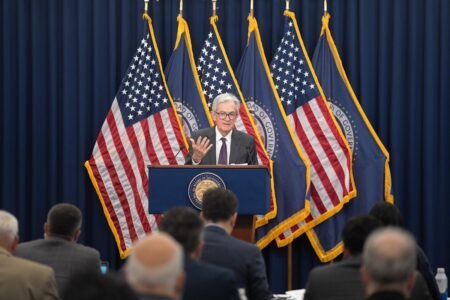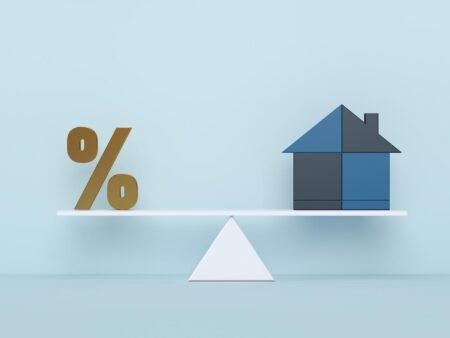Many factors influence the interest rate you get on a mortgage loan, including your credit history and the size of your down payment. Average loan rates across the country also play a role — and those tend to rise and fall with inflation. The September Consumer Price Index (CPI), a key measure of inflation, showed that prices rose within expectations. So, how will that affect home loan rates?
In this article:
Before understanding how inflation affects mortgage rates, it’s first essential to know what inflation is and how it’s measured. At its most basic, inflation is the general rise in goods and services costs over time. In short: It’s the reason your grandparents could purchase a home for just $20,000 in the 1960s (that same amount now translates to over $200,000 in 2025 dollars).
In the U.S., inflation is measured by two different economic indexes: the Consumer Price Index, or CPI, and the Personal Consumption Expenditures price index, or PCE. The Bureau of Labor Statistics uses the CPI to measure the price changes that everyday Americans face. The Federal Reserve primarily uses the PCE to determine policy strategy, as it measures the change in pricing on all items consumed within a given period — not just the out-of-pocket consumer expenses.
The September Consumer Price Index (CPI) showed that prices rose only incrementally higher — but “remain sticky,” Kyle Rodda, senior financial market analyst for Capital.com, wrote in an analysis.
“The belated CPI data showed a better than expected outcome, revealing a decline in core inflation on an annual basis to 3.0% – down from 3.1% a month earlier and below the forecast of 3.1% for the month,” Rodda added.
Mortgage rates are always in flux, but the average rate on 30-year mortgage loans in Q3 2025 was 6.38%, according to data from Freddie Mac. That’s down from the Q1 2025 average of 6.83%.
These rate fluctuations are partially tied to inflation and the policy changes the Federal Reserve makes in response to monthly inflation readings. We’ll discuss these policy changes and their impacts below.
Since its founding in 1913 via an act of Congress, the Federal Reserve has been tasked with maintaining economic stability in the United States, specifically regarding inflation. That’s because too much or too little inflation can cause economic distress.
On the other hand, consumers don’t spend as much money when inflation is low or stagnant, not even when prices are lowered to tempt more people to make purchases. Low inflation can be a sign of tough economic issues, meaning people might be out of a job or facing other financial problems that keep them from buying goods.
Both high and low inflation can be bad for the American economy and the general consumer. The Fed works to keep inflation at a healthy rate of approximately 2%, most notably by setting the federal funds rate, which is the interest rate that banks charge when they lend to other banks.
Banking institutions must manage large sums of money daily. To do so, sometimes they borrow cash from another bank through the Federal Reserve System.
These loans are made overnight so the borrowing bank can meet its liquidity needs the next morning. And just like a consumer loan, the borrowing bank has to pay interest on the loan to the lending bank.
The benchmark interest rate banks charge each other for these overnight loans is called the federal funds rate. When lending to consumers, on the other hand, banks offer interest rates based on the federal funds rate plus an additional margin to ensure they make a profit. That’s why interest on mortgages and other consumer loans is typically higher than the federal funds rate.
Inflation and the federal funds rate
The Federal Reserve adjusts the federal funds rate to help shape the country’s economy. When inflation is high, the Federal Reserve might increase the federal funds rate in an effort to slow down inflation. The thought is that fewer people will borrow money when rates are higher, which can help reduce the influx of cash into the economy and thereby stabilize inflation.
According to the September CPI, prices increased by 3%, after rising 2.9% in August. That was generally better than economists had expected.
With Wall Street in earnings season, the news so far has been positive. U.S.-China relations are cooling, with trade talks resuming, and the Fed is set to lower short-term interest rates again on Wednesday.
The Federal Reserve must adjust the federal funds rate in response to economic changes, so it’s impossible to predict when mortgage rates will go down (especially in the long term) since we cannot know future inflation rates. For example, the market downturn that accompanied the onset of the COVID-19 pandemic had a major impact on the American economy — and mortgage rates — and it was impossible to predict.
However, even though we can’t know what future inflation will be, the Federal Reserve does create a regular inflation report to forecast where the economy will go over the coming year and decade. Though this report obviously can’t guarantee the future, it does use known parameters to set expectations for future inflation. As of September 2025 — the most recent inflation data at the time of writing — the Fed forecast 3.4% inflation for the coming year. This is based on various factors, including the CPI and PCE.
Inflation can certainly impact mortgage rates, but it impacts home buyers in other ways, too. For one, it can send housing prices upward. As the prices of goods and services rise, so do the costs of material and labor to build and sell homes — which means higher home prices for consumers.
Buyers may also face higher prices on various closing costs and third-party services surrounding their purchases, like inspections, appraisals, moving costs, and more, as these can also rise due to inflation.
There is a benefit, though: Inflation — and the higher prices that come with it — could reduce demand for homes and make the housing market less competitive. This could make it easier to snag the house you like without getting into a bidding war or haggling with the seller.
Inflation reports such as the Consumer Price Index and Personal Consumption Expenditures price index reports will not directly affect mortgage lenders’ interest rates. However, what those reports indicate for the future — and the Federal Reserve’s response to those expectations — will. Generally speaking, as inflation rises, so do interest rates, including those on mortgages.
When inflation rates rise, the Federal Reserve generally increases the federal funds rate, which leads to higher interest rates on consumer borrowing products too. By increasing interest rates during periods of inflation, the Fed helps to slow down consumer spending and get inflation under control.
It is impossible to know for certain where mortgage rates will go in the future since unforeseen events that affect the economy (like COVID-19) cannot be predicted. Based on Fannie Mae’s September Housing Forecast, though, mortgage rates are expected to be basically flat over the next few months, with the average 30-year rate sitting near 6.4% by year’s end. The 2026 forecast is for rates to edge down to 5.9%.
Homeowners usually benefit from inflation, as home prices tend to rise when inflation does. That means they gain more equity and can potentially earn more profit from their homes when it’s time to sell. Home buyers, on the other hand, do not benefit. They typically face higher mortgage rates and higher home prices when inflation increases.
This article was edited by Laura Grace Tarpley.
Read the full article here












